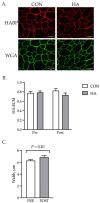Intravenous Injection of Sodium Hyaluronate Diminishes Basal Inflammatory Gene Expression in Equine Skeletal Muscle
- PMID: 37835636
- PMCID: PMC10571686
- DOI: 10.3390/ani13193030
Intravenous Injection of Sodium Hyaluronate Diminishes Basal Inflammatory Gene Expression in Equine Skeletal Muscle
Abstract
Following strenuous exercise, skeletal muscle experiences an acute inflammatory state that initiates the repair process. Systemic hyaluronic acid (HA) is injected to horses routinely as a joint anti-inflammatory. To gain insight into the effects of HA on skeletal muscle, adult Thoroughbred geldings (n = 6) were injected with a commercial HA product weekly for 3 weeks prior to performing a submaximal exercise test. Gluteal muscle (GM) biopsies were obtained before and 1 h after exercise for gene expression analysis and HA localization. The results from RNA sequencing demonstrate differences in gene expression between non-injected controls (CON; n = 6) and HA horses. Prior to exercise, HA horses contained fewer (p < 0.05) transcripts associated with leukocyte activity and cytokine production than CON. The performance of exercise resulted in the upregulation (p < 0.05) of several cytokine genes and their signaling intermediates, indicating that HA does not suppress the normal inflammatory response to exercise. The transcript abundance for marker genes of neutrophils (NCF2) and macrophages (CD163) was greater (p < 0.05) post-exercise and was unaffected by HA injection. The anti-inflammatory effects of HA on muscle are indirect as no differences (p > 0.05) in the relative amount of the macromolecule was observed between the CON and HA fiber extracellular matrix (ECM). However, exercise tended (p = 0.10) to cause an increase in ECM size suggestive of muscle damage and remodeling. The finding was supported by the increased (p < 0.05) expression of CTGF, TGFβ1, MMP9, TIMP4 and Col4A1. Collectively, the results validate HA as an anti-inflammatory aid that does not disrupt the normal post-exercise muscle repair process.
Keywords: equine; exercise; hyaluronic acid; inflammation; skeletal muscle.
Conflict of interest statement
The authors declare no conflict of interest.
Figures






References
LinkOut - more resources
Full Text Sources
Research Materials
Miscellaneous

